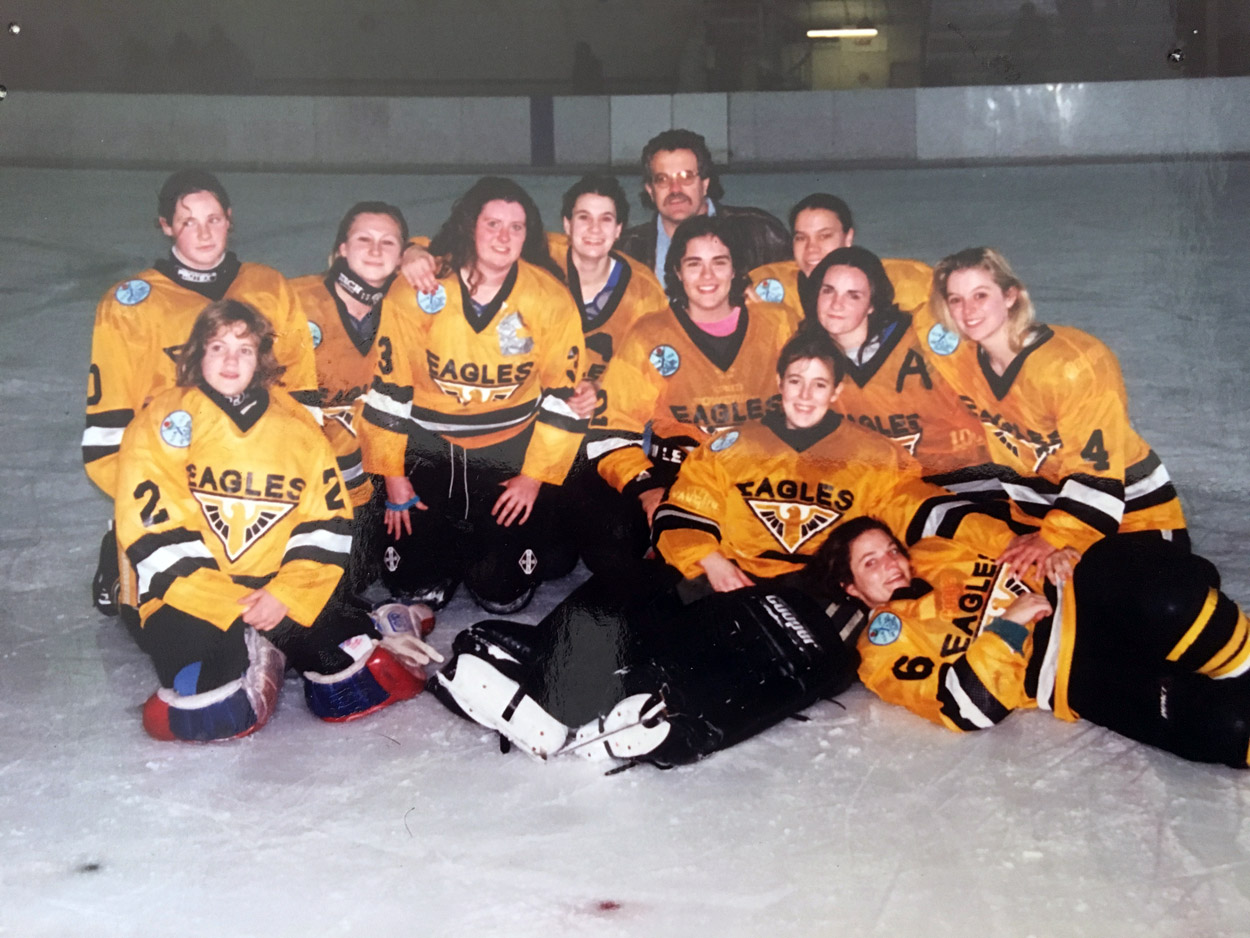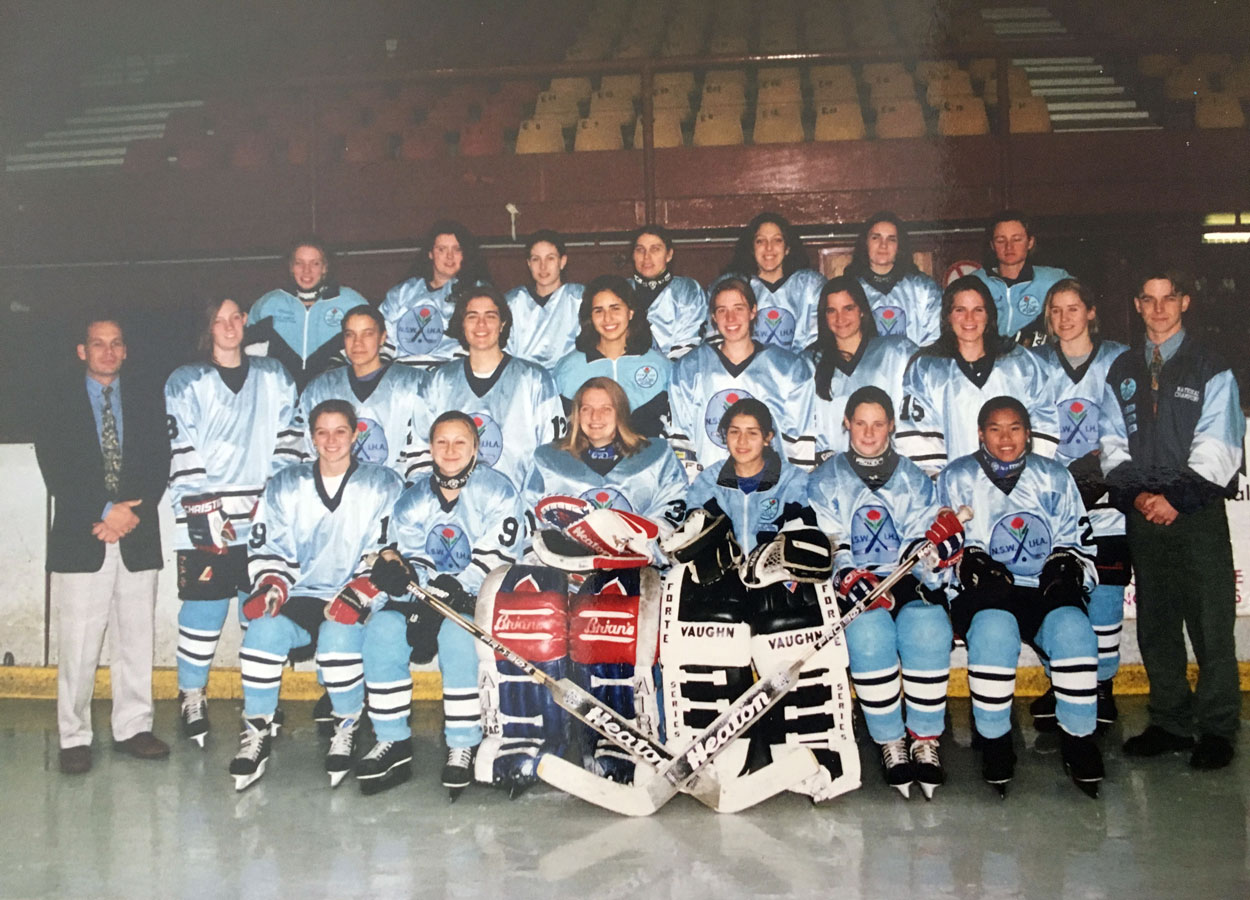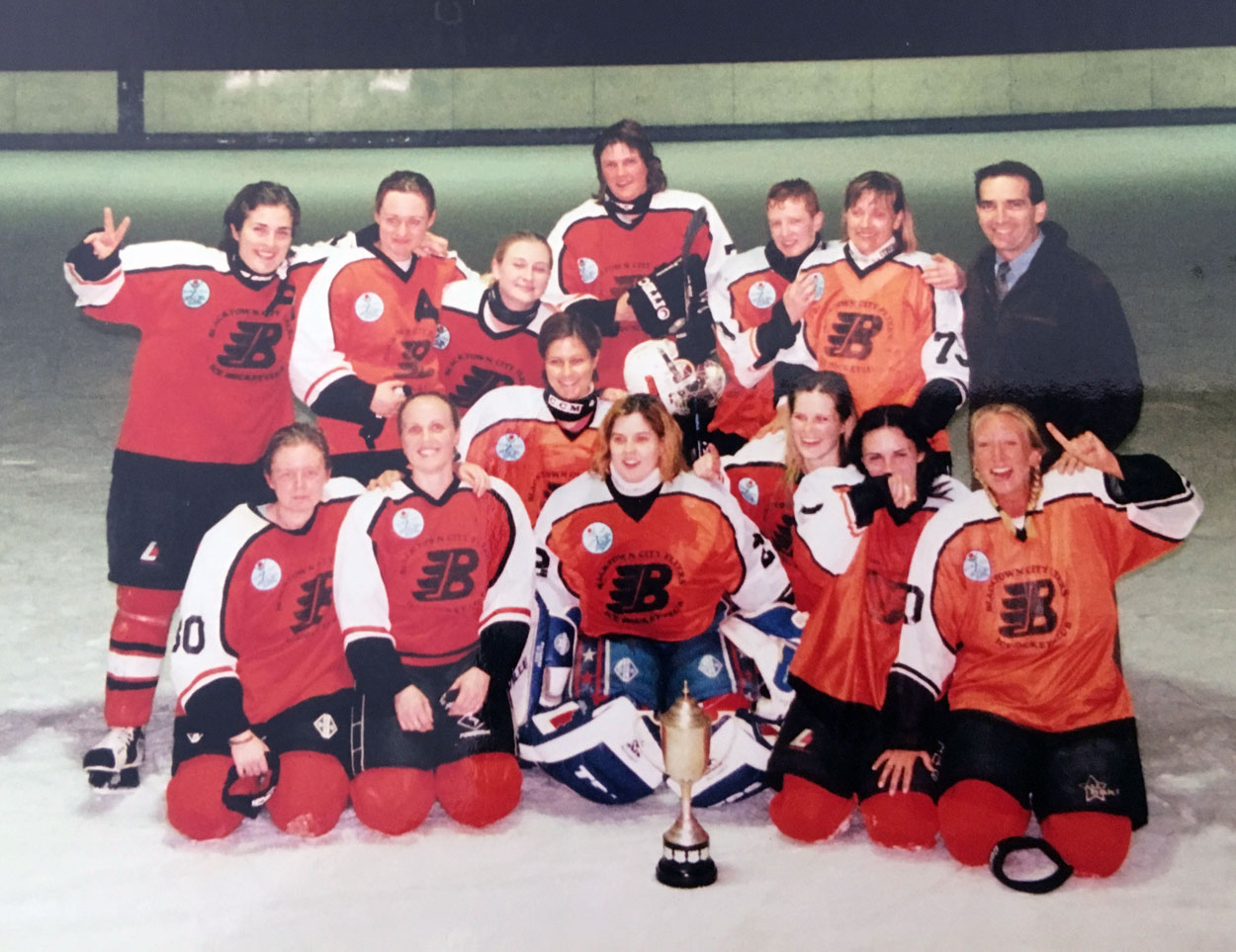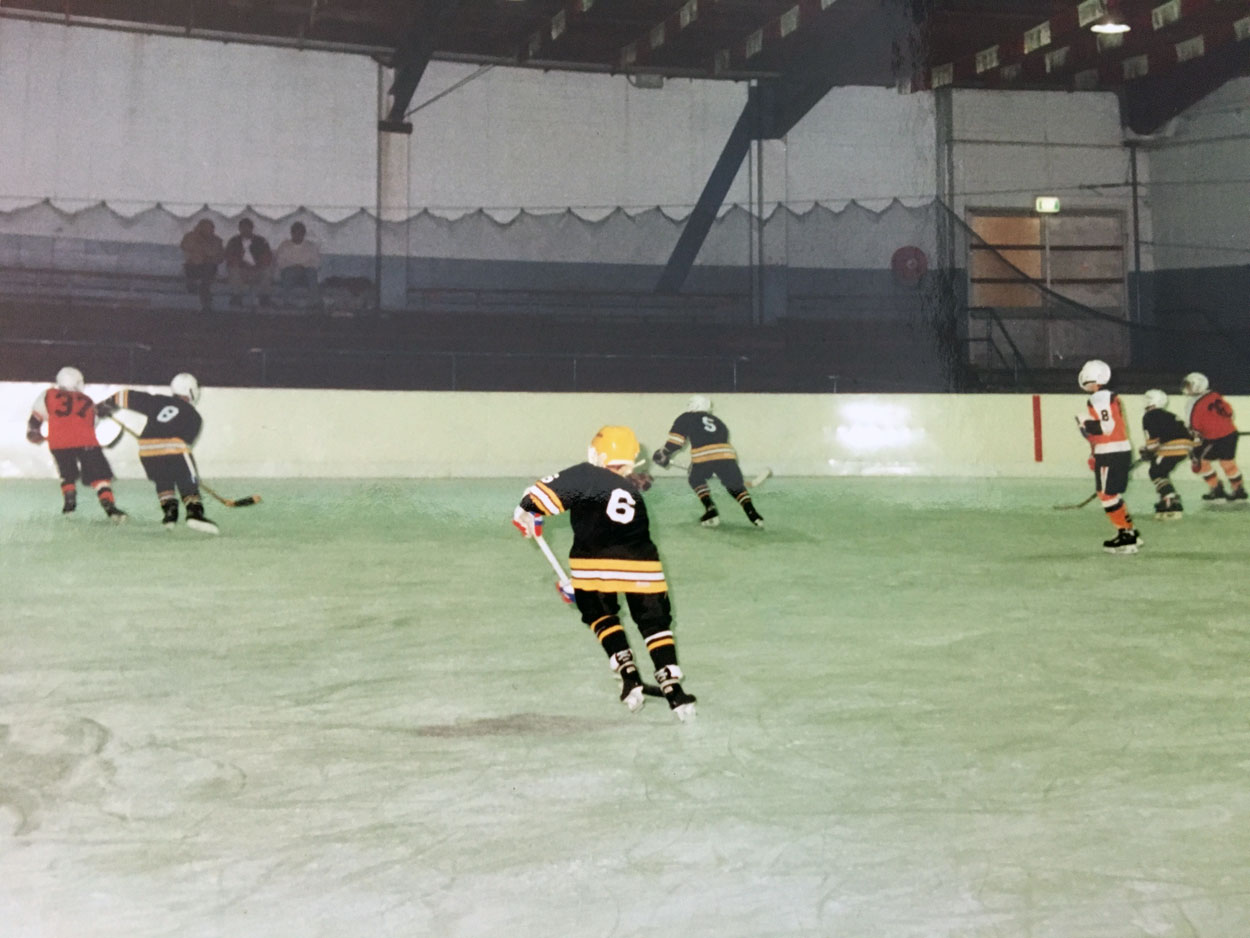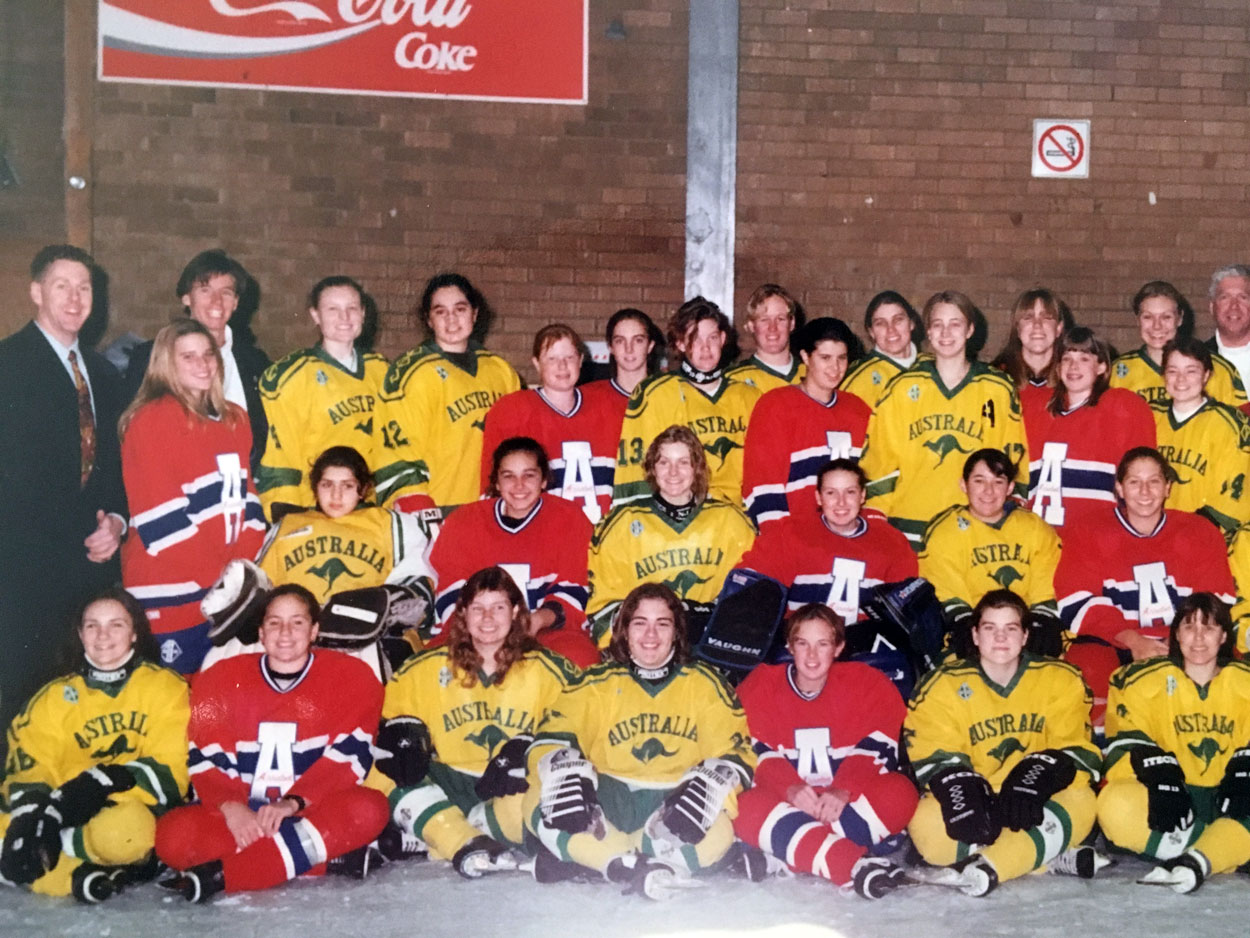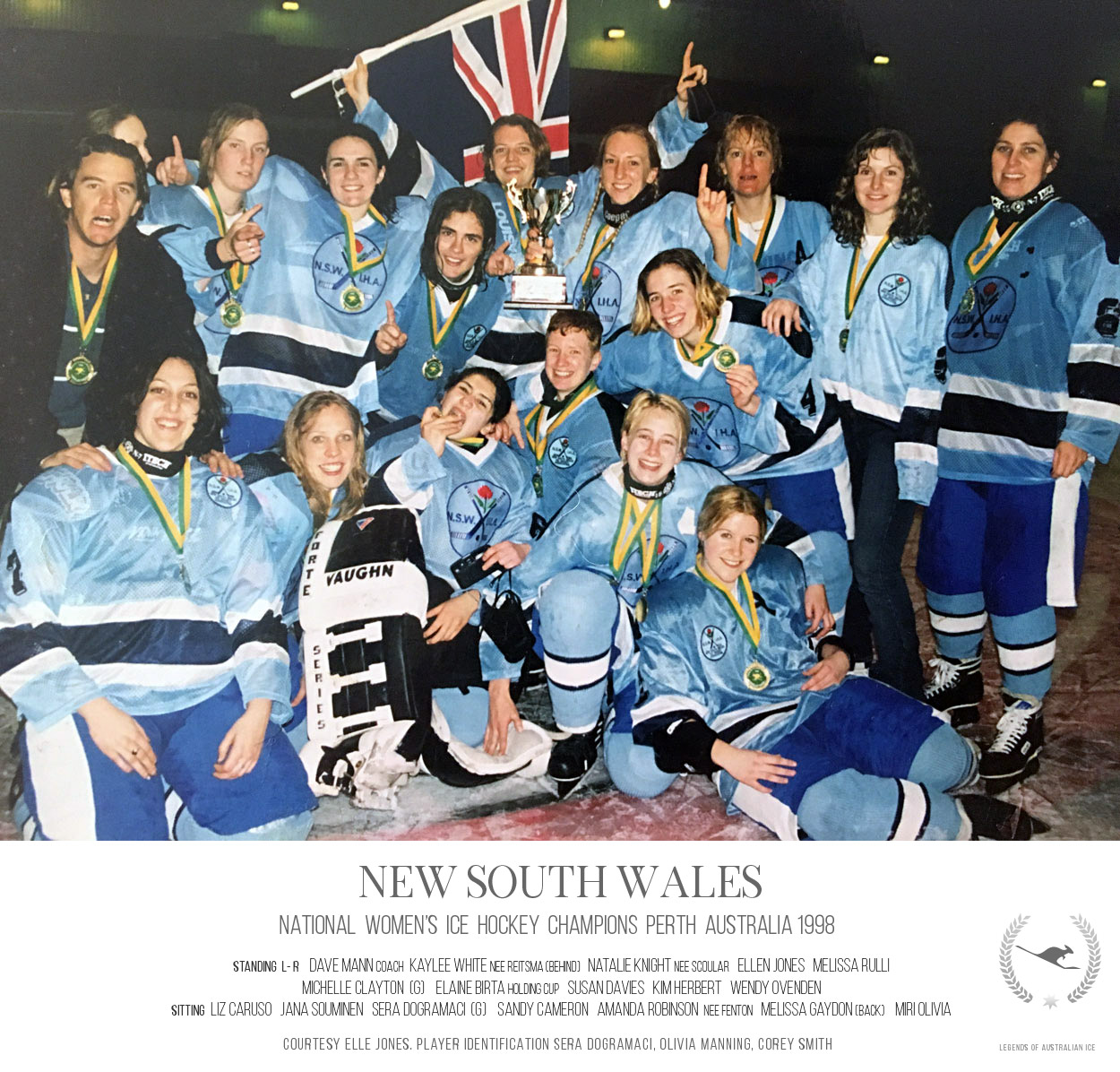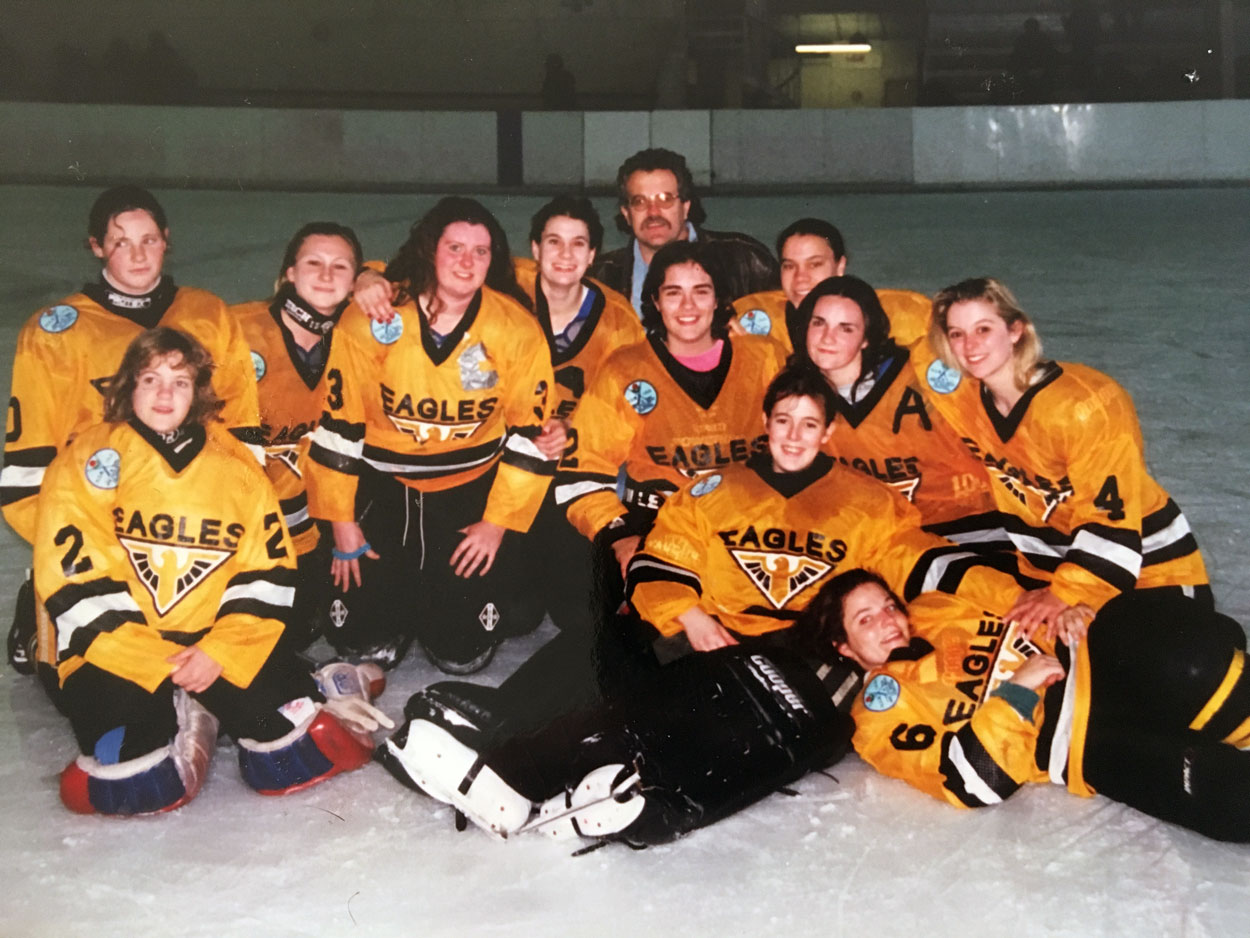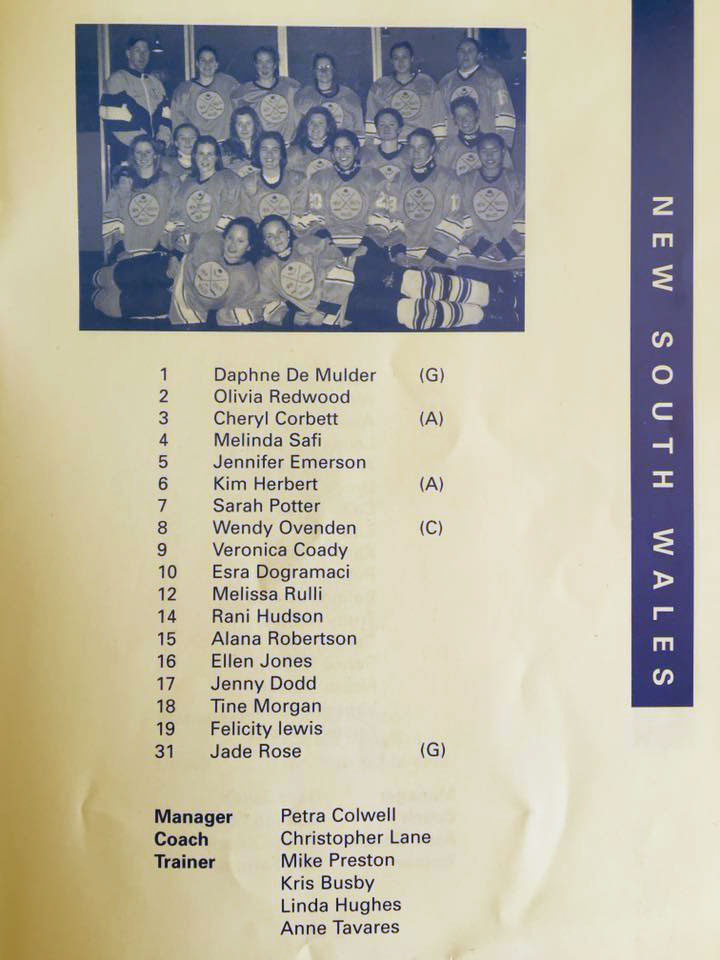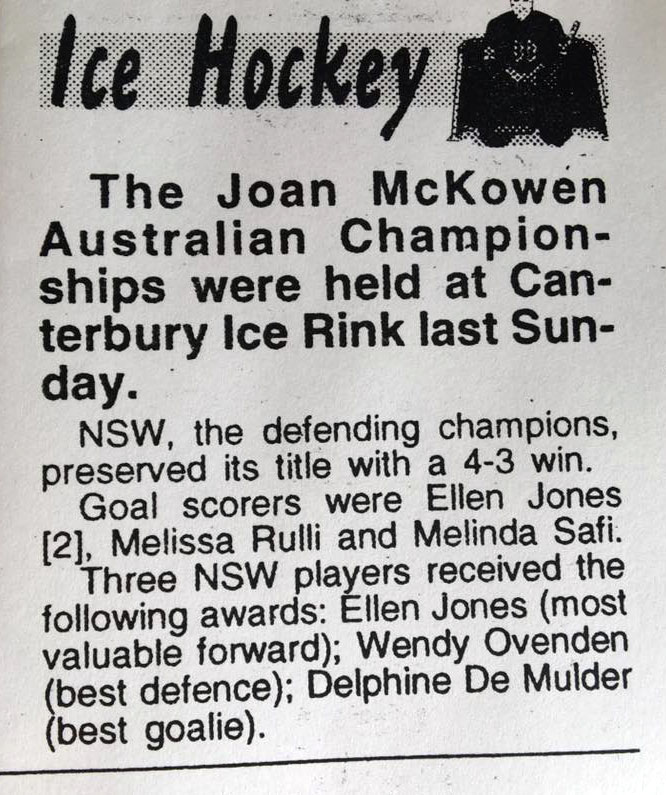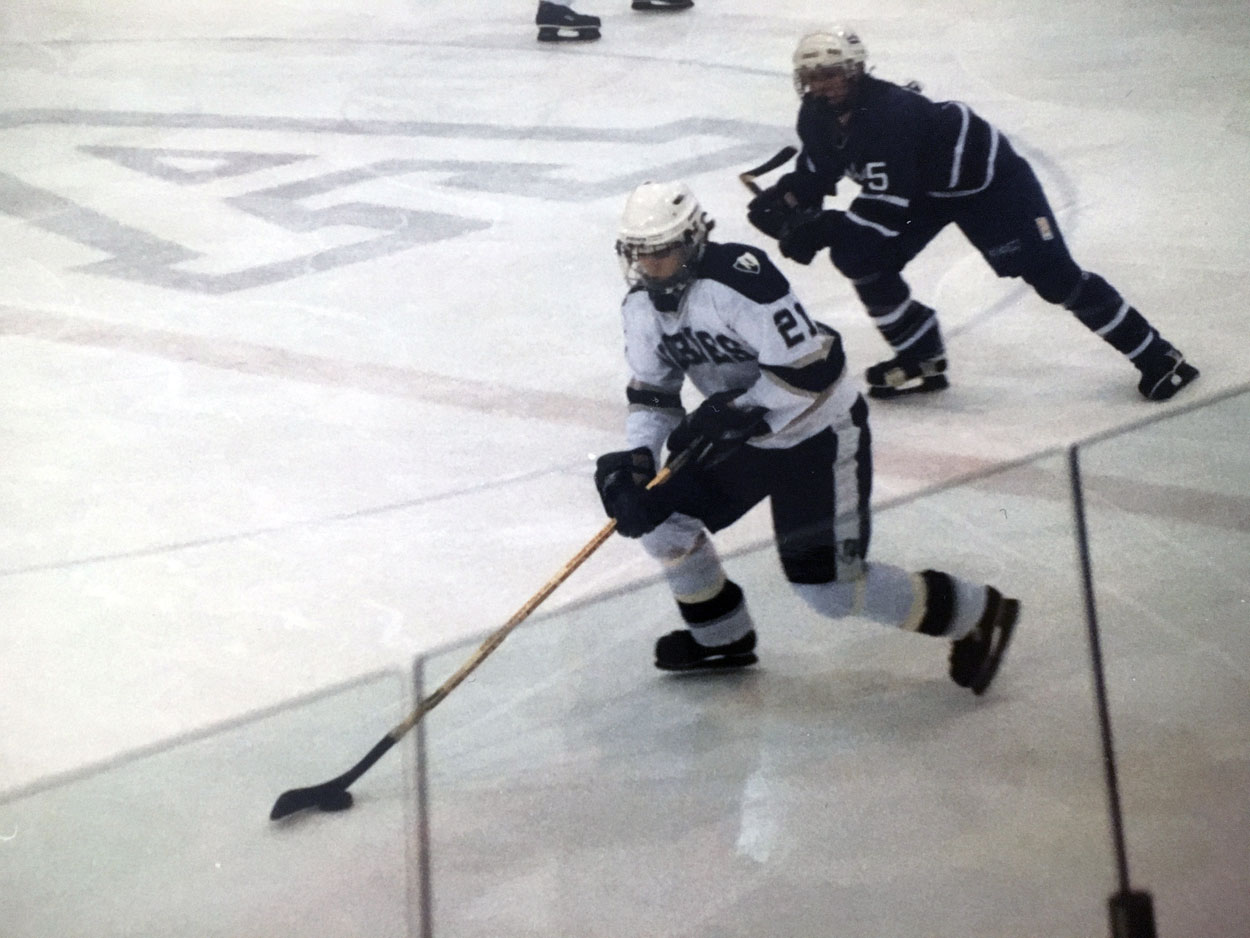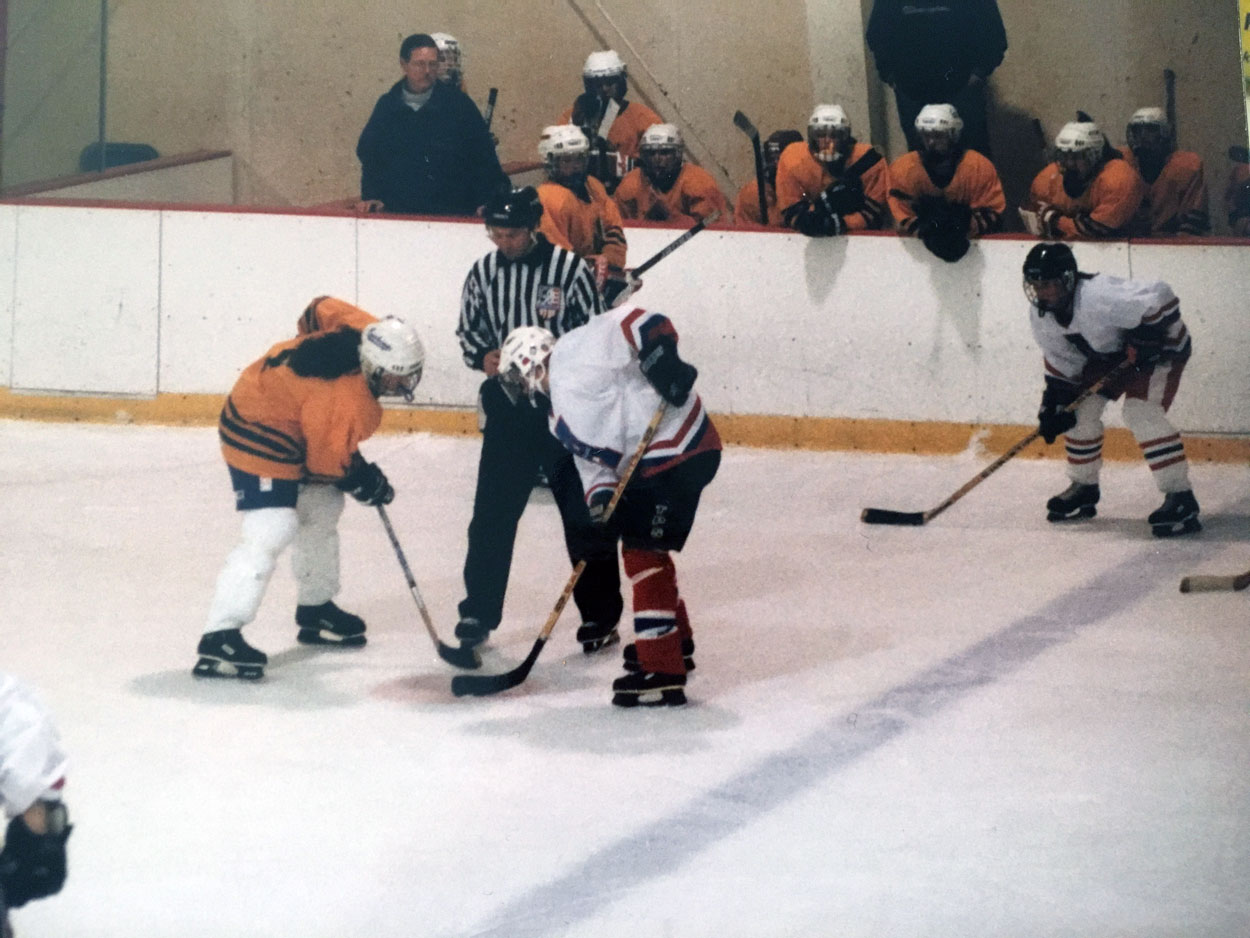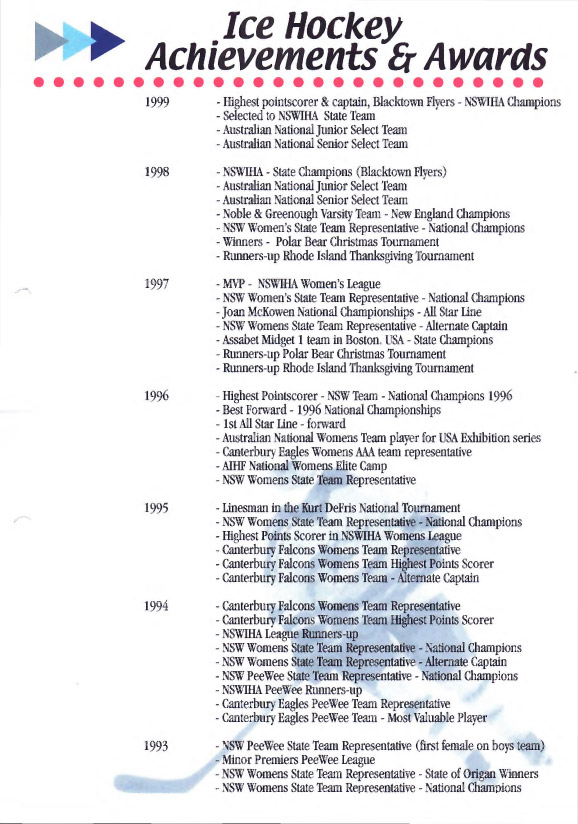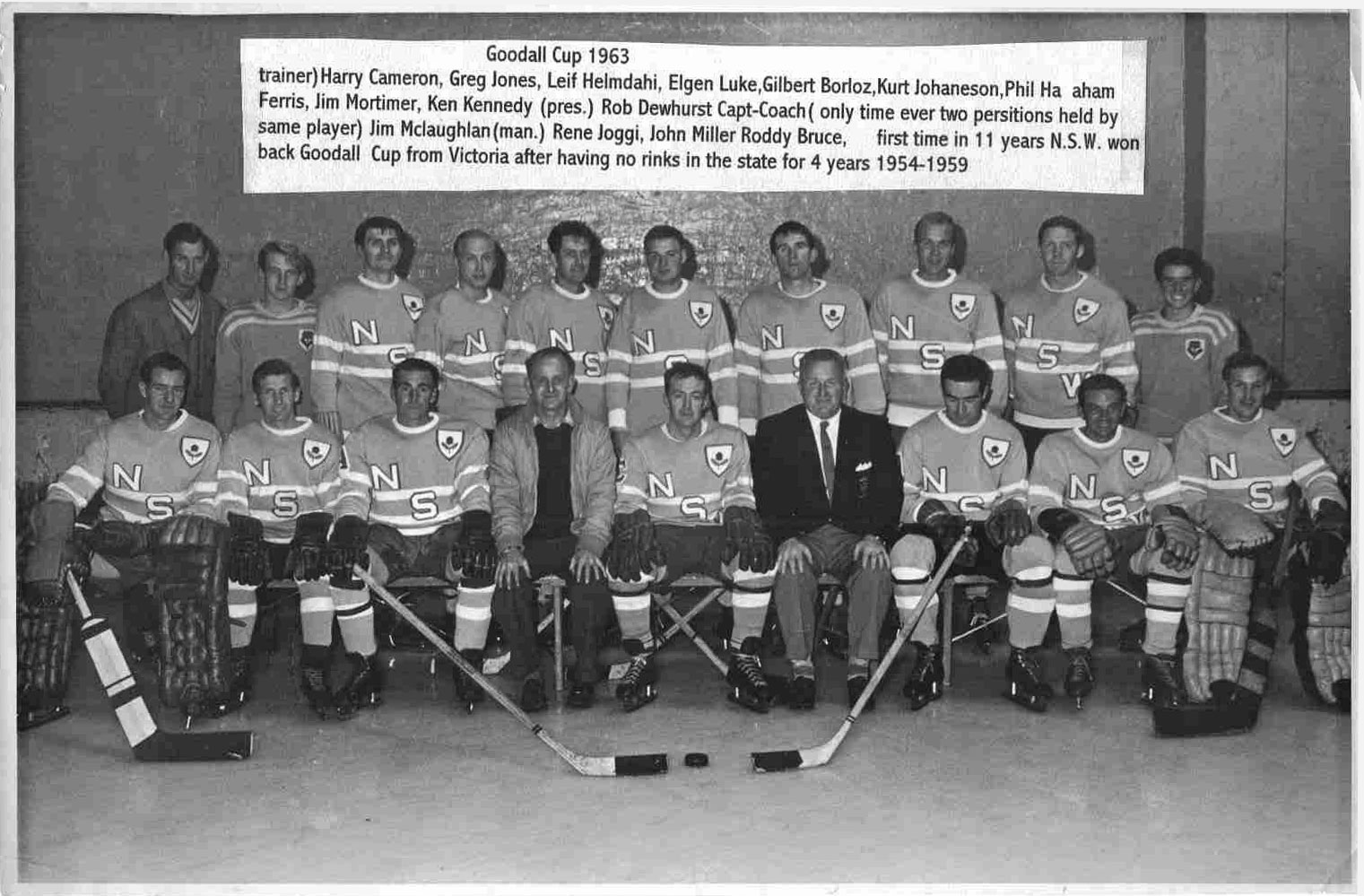
Taboo
Ellen Jones and the magic skates
My philosophy is simple but it instills self-confidence. I address that issue with every 9- and 10-year old. Once they know what it is, that stays with them the rest of their lives. I ask a 9- and 10-year old to put their arm around their mom and dad once a week, look them in the eye and say they love them. If they can do that, they will be a great team member.
— Carl Gray, Assabet Valley women's hockey founder, Women’s College Coaches Joe Burke Award recipient (1978), William Thayer Tutt Award recipient (2004), Massachusetts Hockey Hall of Fame inductee (2005). [6]
SHE WAS THERE IN FULL HOCKEY GEAR handing-out pamphlets for the state association when The Mighty Ducks premiered at the Greater Union George Street in Sydney. The west side back then contained only the Big-Three cinemas — Village, Greater Union and Hoyts. You may not remember now when you see the black and metallic gold jerseys with orange accents, but the NHL awarded the Walt Disney Company an expansion team just sixty-nine days after the opening of this children's movie, the movie that had essentially paid for the Mighty Ducks hockey team.
It was 1993 and she was eleven and off to Champions with her own expansion plan, which she assumed was clearly outlined in the association pamphlet. For it was there that she hoped to recruit a few girls for hockey from the crowds of kids who had turned out to the Greater Union cineplex on the site of the old Rapallo and Paramount cinemas. Maybe even catch another peek of the thoroughly modern moviegoing experience herself.
The movie strip there had undergone many drastic facelifts and overhauls since 1971 when the Hoyts cinemaplex next door replaced the iconic Trocadero dance hall. The demise of "the Troc" was a most unfortunate event, long lamented in the Richard Clapton ballad, Girls on the Avenue. Its owner, Jimmy Bendrodt, was also creator of the Ice Palais, Sydney's second ice rink, which he had located in the Hall of Industries at the showgrounds long ago, before even her own father had played.
That's the way it was for the young Elle Jones. Her family might be old but it was no stranger to ice hockey. There was a time when her late uncle, Greg Jones, had played at the new outdoor rink at Prince Alfred Park in Sydney, and that’s where her father, Terry Jones, also played as a young boy. Uncle Greg had won a Goodall Cup with New South Wales in 1963, doing his bit to break the stranglehold Victoria had held on the competition since the Second World War. All the more remarkable because the state had been without an ice rink for the five seasons between 1956 and 1960.
Her uncle's teammates included Captain Rob Dewhurst of the St George club, a 1960 Ice Hockey Olympian at Squaw Valley in Calfornia; and Coach Ken Kennedy, Australia's first Winter Olympian. New South Wales went back-to-back the next year but it was the '63 team photo on which Dewhurst chose to proudly plaster his note. "Winning back the Goodall after 11-year drought and 4 years without rinks in NSW 1963". A small girl grows up among all this with certain expectations and it is fair to say the young lady of whom I speak was as close to local hockey royalty as one could be in Sydney in the early-nineties, some years out from the state's first women's league.
Born December 29th 1981 in Sydney, first-hand experience of hockey had not stolen into Ellen Jones' childhood until she saw her older brother play. A conspiracy perhaps, because back then it seemed he rose early every single morning and headed down to Canterbury ice rink for the 6am training sessions. Although in certain circles in Australia in those days, a girl or woman playing ice hockey was still frowned upon as being a “Tom Boy”, it was trivia of which she was still blissfully unaware. She was at an age where perfectly normal meant wanting to do everything Morgan did, and the grave injustice of not being allowed was simply incomprehensible. It served only to add fuel to the fire.
"Hockey wasn’t something I wanted to just be a spectator in," she says with a flat, steely resolve that smacks of a long rebellion against an insufferable idea. Her father met her constant hankering and harassments about having a go with an equally bombarding "no". No, no, no. No other girls are playing. Until, one day, one enchanted day, everything changed. On her bed when she came home was a pair of Bauer skates. No fairy dust or pink unicorns. Just the most magical skates in the world.
From that time on, weekends and most week nights were spent either at social sessions at the rink, or doing the learn-to-skate and dance classes in her hockey skates with father. "Im sure at the time I scared a lot of the figure skaters," she says, and you can hear a certain satisfaction in the words as they twirl in the air. "I was in Year-6 when I first started, eleven years of age ... I remember this well because I have only one eyebrow in my Year-6 school photo, courtesy of rookie initiation for the NSW State Peewee Team". That was 1992, the year of the Winter Olympics in Albertville, France, the year a Minneapolis "District 5" PeeWee hockey team called The Mighty Ducks was released in the US.
The film premiered in Australia in 1993, turning into a flood the flow of prospective new players that had begun with the Winter Olympics. Chris Pett formed Warringah Wild Cats at Narrabeen that season with Jenny Dodd as captain and club secretary. Affiliated with the Warringah Bombers, the Wild Cats were the state's third women's ice hockey team — Canterbury, Blacktown and Narrabeen. [2] "Jenny is fiercely loyal," according to Wendy Ovenden, a veteran player of the time. "That's why we love her so much, and without her and Chris Pett at the helm at Narrabeen, there may well not have been a league in Sydney".
Jones played centre representing New South Wales in both boys and women's leagues and local hockey for the Canterbury Eagles Peewees for two years. The 1994 New South Wales Peewee Premiers were mostly boys and twelve year-old Jones, the first female on a local boy's team of her time. Their Most Valuable Player that year, she made the cut for the NSW state teams that went on to win both the State of Origin and the National Championship.
After Peewees came contact hockey which girls were not permitted to play, but fortunately for Jones, women's hockey was about to change phenomenally. Her father was busily creating the state's first women's ice hockey league, while she was finishing up with the Peewees in 1994. Terry Jones and John Wilson, the father of Australian ice hockey champion, Anthony Wilson, also created the development league at Blacktown Ice Rink, providing a pathway for beginners to pick up the sport in full kits of rented gear.
A safe haven with minimal outlays, it was a place where prospective new players could learn a little and get comfortable before joining the women's competition. By 1998, it consisted of under-14, under-16, under-18, and under-21 women's teams. [3] Other young girls like Jones, who were also eleven and twelve years of age, were taking over the ice and developing well. The first Australian women's teams were open age limit, but players from twelve or thirteen years of age were quite common and a lot of great players were recruited to Jones' team that way.
In 1994, she was Highest Points Scorer for the Canterbury Falcons and played in the Able Press Cup at Narrabeen, the predecessor to the Joan McKowen National Women's Championship. "Getting the Able Press Cup running was a major deal", writes Jenny Dodd, "and we had absolutely no subsidy from NSWIH, we fundraised in order to host and hold our tournament, as we did the ones that followed. I believe it was a first that a tournament actually made money. A lot of hard work for Wendy [Ovenden], myself, Chris Pett and Terry Jones as the association were not willing to support our endeavours, and this was voiced through Nancy, the Bombers secretary at the time, at many meetings I went to". [2]
Jones was an Alternate Captain while still the youngest on the team — "unfortunately a reoccurring pattern" — but she now had some great new players as well, both young and old. Sponsored by Melinda Safi (Kopp), a prominent participating player, the women's invitational tournament was basically "an ongoing State of Origin between New South Wales and Queensland". [2] Won by New South Wales, it was from this 1994 tournament that the Women's Nationals arose, known today as the Joan McKowen Trophy.
"Nineties girls are legends," suggests Dodd, "because we had a league that matched the Junior league which involved Bombers (Narrabeen), Blacktown, Canterbury Eagles (2 teams), Macquarie (2 teams), Canberra. In Winter, on prime-time ice, often before or after Super League games. Without people like myself, Wendy Ovenden, Chris Pett and Terry Jones this would never have happened and what you have today would not exist".
In 1995, Jones won the state Women's Premiership with Canterbury and Highest Points Scorer in the league. It was a boom season for women's hockey, and proud parents of younger players regularly cheered themselves hoarse. Sydney had five women's teams that season — the Canterbury Eagles, Canterbury Falcons, Warringah Bombers, Macquarie Bears and Blacktown Flyers — and Canberra were also considering the commute to play in the League. [3] Jones continued on as Alternate Captain and Highest Point Scorer of the Falcons under a few different coaches.
In 1996, now 15 years-old, her state team were again national champions. She won the Joan McKowen Trophy, Best Forward, and First Line All-Star. The state's second consecutive title was won against teams from the Australian Capital Territory, New South Wales, South Australia and Western Australia on the newly enlarged Canterbury Olympic ice rink in Sydney. That year, development of elite women players was focused on qualification for the 'expanded' World Championships proposed for 1999, and she attended the national association's elite development camp coached by Heather Linstad of Northeastern University in Boston, Massachusetts. It was also the year that the first ever Australian women's team played the touring ice hockey team from Assabet Valley in the USA.
* * * * *
In the early years, high school hockey in the USA wasn’t available to girls until they were delivered out of the Dark Ages by an increase in popularity and the enforcement of Title IX — a law prohibiting discrimination on the basis of sex in any federally-funded education program or activity. The law has still not provided for complete equality, but it did clear the way for a lot of girls to play college hockey after high school at such institutions as Harvard, Brown, Dartmouth, Cornell, Providence and UNH. [5]
The ground-breaking women’s hockey teams of Boston, such as Assabet Valley Girls founded by Carl Gray in 1972, the Massport Jets and the Stoneham Unicorns, began the dismantling of the taboo when they took to the ice from the early-70s. Acceptance was slow, but by the late-70s the tom-boy image began to lose its grip. [5] The Valley Sports Arena’s twin rinks in Concord, with Carl Gray’s Assabet Valley teams, hosted women’s hockey games at four different age levels, from Squirts to Senior A’s, on weekends from October to April. There were multiple teams at each level actively competing throughout the year with state and national championships at stake at year’s end, and all under the watchful eye of the national amateur association.
Although outclassed by the touring Assabet Valley team in 1996, the Australian girls played with great heart and showed that with ongoing development and broader experience they would eventually make their mark on the world stage. [3] But, perhaps more importantly, they had forged a symbolic connection to the trail-blazing women of the international game, using it over the next few years to catapult themselves onto the world stage. Jones herself had hit the fast-track. Drafted during the tournament by Carl Gray, the tourists' head coach, she was given the opportunity to train at his rink in Boston, join his hockey program, and apply for school scholarships. It is still one of her favourite hockey memories.
Gray has spent most of his adult life helping to grow and improve the game of women’s hockey by creating a balanced, yet prestigious program in Boston. Driven by a passion for giving girls the same opportunity as their male counterparts, he has produced numerous National, State, League, and Tournament Championships, and many players who have gone on to compete in the College and Olympic ranks. In fact, his program has developed more Division I and US Olympic team players than any other all-girls’ programs in the country. “I had two boys and two girls and I wanted my two daughters to have the same opportunity in life that my two sons did,” he has said. “I decided to start a program and got involved in the ownership of the Valley Sports Arena. I had the opportunity to make things happen.” [6]
Not surprisingly, it was from there that doors opened for Jones. She was awarded a full hockey scholarship to the Noble and Greenough school in Dedham, Massachusetts, following in the footsteps of trailblazing Australian goalie, Damian Holland, who had won his way to the University of Illinois some years earlier (1989-92). Still in her teens, she was one of the first women to accomplish the feat from Australia, and she remained there at Nobles on her own for two years before returning home to her family.
In 1997, she was again a National Champion and MVP of the state league. She was also a State Champion with the Assabet Midget 1 team in Boston and runners-up in the Polar Bear Christmas and Rhode Island Thanksgiving tournaments. In 1998, her Nobles Varsity Team were National Champions. She made both the Australian Select Teams, Junior and Senior, which offered elite level female competition during the regular season of the Northern Hemisphere so that players competed in the Worlds in peak condition.
From that year on, she played for the Blacktown Flyers, coached by her father. The Flyers won two NSW championships (1998, 1999) before the rink closed in 2007 after twenty-nine seasons. The next season, she was Highest Point Scorer and Captain, again making both Junior and Senior Select Teams.
From the age of 18, Jones represented Australia four times in World Championships or qualifiers — 2000, 2001, 2004 when Australia was first promoted to Division II, and 2007. "Obviously making the first womens team was one of the biggest moments for me — pretty much felt like my awkward teenage years caught on film." She had the highest Plus-minus for Australia in 2001 and second top points in 2004.
It was in one of those Women's Worlds that she broke her arm in an exhibition game against the Swiss B team. She was rushed to hospital in full hockey gear and only allowed aspirin due to drug restrictions. She played the entire tournament with the arm in a cast and even scored a goal. "It came off my skate so don’t tell anyone!", she laughs, but you also know it just wouldn't have happened had she been nursing broken bones on the bench. Later, the arm had to be reset because the hospital got it wrong.
Among Elle Jones' career highlights are winning a gold medal in Sheffield, England, and her first ever face-off for the women’s team in a Worlds tournament, "Which I may have lost, but only Mel Rulli knows!" Now divorced, she has two young children — Ivy, 6, and Tyler, 5. Their father is also a hockey player, "so who knows if they’ll be the next generation to take it up?" A few years break from the sport she loves was unavoidable whilst having children, but Little Sister still goes to watch Morgan play for the Canterbury Eagles Senior-A team, a sure sign she is harassing someone about playing hockey once more.
 Ellen and Terry Jones, 1996
Ellen and Terry Jones, 1996

Citations
[1] Past/Lives of the Near Future, Greater Union/Event Cinemas, George Street, Sydney, NSW, April 3, 2012.
[2] Dodd, Jenny, private correspondence, 5th and 7th October 2016
[3] The Women's Hockey Web, Andria Hunter, Women's Hockey in Australia, 1998.
[4] Ovenden, Wendy, private correspondence, 6th October 2016
[5] Women’s Ice Hockey - Shattering tradition, David Maroney, Daily Times Chronicle, Woburn, MA, USA, December 29, 2015
[6] Special to USA Hockey, Grandfather of New England Girls’ Hockey Still in the Game, Mike Scandura, 2016
[7] Biographical notes and correspondence, Ellen Jones, November, 2016.

